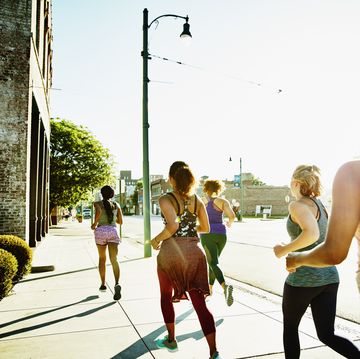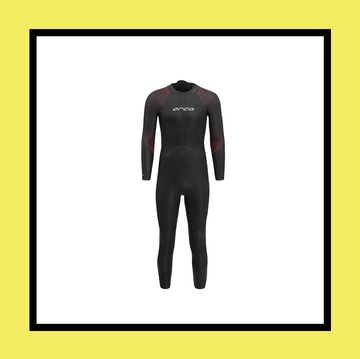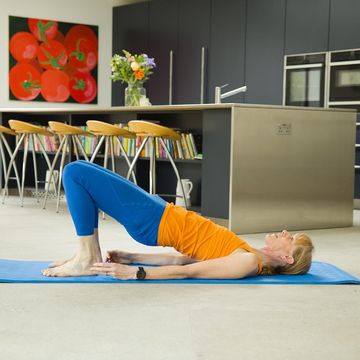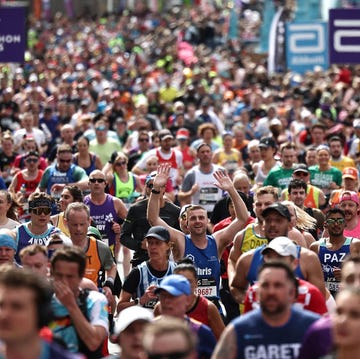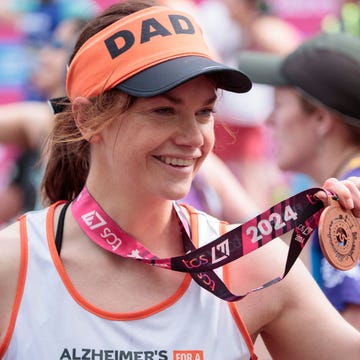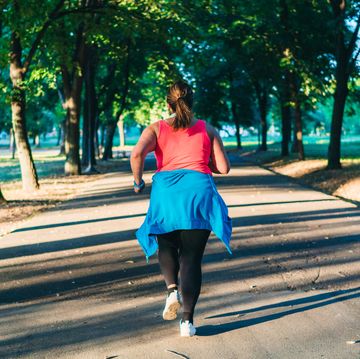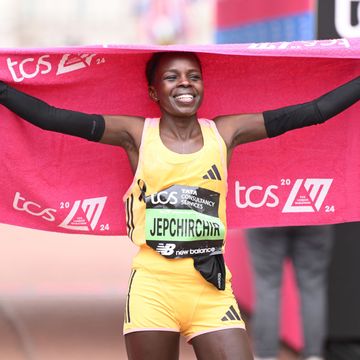Jump to:
- How many miles are in 10K?
- How much time do I need to train for a 10K?
- What is the average 10K time?
- What is the 10K world record?
- How do I go from couch to 10K?
- What time should I aim for?
- What paces should I train at?
- Can I predict my 10K time based on my parkrun time?
- Four-week 10K training plans
- Eight-week 10K training plans
- How should I pace on the day?
- Am I too old to run a 10K PB?
- How do I fuel a 10K?
- How much water should I drink during a 10K race?
- I’m finding my training difficult - what should I do?
- What are the best 10K training sessions?
Is there a better racing distance than 10K? The sweet spot between speed and endurance, it presents a challenge to any runner – whether you’re gunning for a PB or simply trying to complete the distance. It’s no surprise, then, that 10K is by far the country’s most popular type of race. To say it’s a versatile distance is an understatement. Take a cross-section of any 10K field and you’ll find a variety of different runners – some tackling it as their first run beyond five miles, others using it to stretch out their legs in company, while some will make it the focus of their whole season.
Whether this is your first 10K, or you’re looking for a training schedule to increase your pace, we’ve got everything you need in our definitive training. So dive on in to find the answers to your most frequently asked questions...
How many miles are in 10K?
In miles, a 10K race is 6.2 miles long.
How much time do I need to train for a 10K?
The variety of training schedules available are based on two things: how often you can train and how long you have till the race. From two-week training plans to eight-week training plans, we’ve got a variety of plans (below) to suit your experience and needs. One thing’s for sure: whether you’re a beginner, a one-off runner doing this for charity, or a seasoned club runner out for a new PB, a solid training plan is your route to your best possible, and most enjoyable, result.
What is the average 10K time?
Average times depend on where you look but Running Level holds data from 50 competitive UK races between 2016 and 2020. The stats calculate an average 10K time as 49:43, across all ages and genders. However, global database RunRepeat reports 1:02:08 as the average 10K time. This is based on the averages from 35 million race results worldwide.
When the sexes are separated, RunRepeat records the average 10K time for women at 1:06:54 and for men at 57:15.
What is the 10K world record?
The record varies depending if you look at track or road results. The men’s outdoor 10,000m world record is 26:01, set by Ugandan Joshua Cheptegi in October 2020. The women’s world record is held by Ethiopia's Letesenbet Gidey, who ran 29:01 in June 2021. On the road, Kenya's Agnes Ngetich set a new women's world record in Valencia in January 2024 of 28:46, while the men's road 10K world record of 26:24 was also set in Valencia, back in 2020, by fellow Kenyan Rhonex Kipruto.
How do I go from couch to 10K?
Completing a Couch to 5K plan first will give you a great baseline of fitness to build upon. Once you have completed this you can build up your endurance by extending your longer runs. Try to increase the length of your longest run by no more than 10 to 15% per week. The technique of Jeffing (a combination of running and walking) can be a great way to increase your distance, and your confidence, at the same time. You can can also follow a 5K to 10K plan.
What time should I aim for?
If you’re a complete beginner, don’t start out with an overly ambitious goal. To give yourself a ballpark 10K target, see how far you can run at a sustainable pace in 15-20 minutes. Then measure this distance in miles, divide the time by the distance and multiply the result by 6.2 to get a rough figure for your first 10K race. If that math sounds a little too complicated, try our race time predictor tool.
For experienced runners, you can be a bit more structured. If you can run 5-6 x 1K or 3-4 x 1 mile at your target 10K pace with three-minute recoveries, you should be able to hit your goal. We’ve also got time related 10K training plans below to help you reach your goal.
What paces should I train at?
British Olympic distance runner Chris Thompson, who boasts a 27:27:36 10K PB, says, ‘In terms of pace, you have to train over-distance, under-distance and at distance. So in terms of 10K training, I’d try to dedicate an equal amount of effort each week to training like I’m running a half-marathon, training like I’m running a 5K and training like I’m running a 10K. Then, as you hone in on race day, you focus more and more on specific 10K work.’
Can I predict my 10K time based on my parkrun time?
‘I think you can make pretty good assumptions about what you can run for a 10K, when you’re running certain things for a 5K,’ says Thompson. 'If you’re training for a 5K, specifically, I think there’s a good chance you’re probably doing enough [to make an accurate estimation of your 10K time]. If you can 20 minutes for 5K and want to run 40 minutes for 10K, you might fall short, but it won’t be by too much.’
The best 10K training plans
We’ve broken our training plans down into time before the event, and runs per week, to help you find the best schedule for you.
Two-week 10K training plans
Two weeks put you in a sort of no man’s land – you can’t improve a great deal in such a short time, but you can do some useful sessions to prepare for the race. If you’re a relatively new runner, it should allow you to learn to run with a degree of efficiency and economy. Regular runners can use the fortnight to fine-tune their existing fitness and practise running at 10K pace.
Four-week 10K training plans
Four weeks is long enough to improve your fitness and put a little edge of speed in your legs. There are two options here: one for runners who can spare three days a week to train and one for those who can run five days a week. Each option loosely relates to a range of target 10K times, and these are shown at the top of each schedule.
The most basic option does assume you’re already running a minimum of three times and 16-20 miles a week, so if you’ve never run before but you’re committed to running a 10K in four weeks’ time, you’d be best to simply focus on building up the length of your runs, rather than following the more speed-orientated structure of these schedules.
Eight-week 10K training plans
You can really see your 10K fitness rocket over a preparation period of eight weeks. As with the four-week schedules, it’s important that you’re flexible in your approach. If the 10K is your single focus for the season and you’re willing to do everything you can for the best possible time, you can add a two-to-four-month build-up period to the schedules, in which you focus on establishing a steady, solid mileage background.
Three-times-a-week runners should build up to a regular 20-25 weekly miles; five-times-a-week runners to 35-40 miles; and those training 6-7 times a week to 45-50 miles. You can vary your pace slightly to maintain interest during these build-up weeks but save the real speed work for the final eight-week focus.
How should I pace on the day?
If this is your first 10K, try and run evenly – a fast start will often mean a painful finish. If you have a target of 60 minutes, you should aim to pass each kilometre marker at six-minute intervals. If you feel great near the end, pick up the pace and speed up.
Alternatively, for those willing to dig deep and hang on, a more aggressive pacing strategy might pay off. And the advantage of a 10K, as opposed to a marathon, is you can afford to experiment, get it wrong, and try again in a month's time.
‘You’ve got to learn how best you function for the event, and everyone’s different,’ says Thompson. ‘When you’re starting out at any distance, go into it with an open mind. Tell yourself, “I might have to do this a few times before I find my optimum performance.” And that okay, because the chance of you nailing a 10K first time out and coming away going “Oh, I couldn’t have got any more out of myself” is so unlikely. We all have to go through that learning process. You can develop a really beautiful relationship with your own “red line” and your own coping mechanisms. Sometimes you can think, “This is impossible, I’m too tired, I can’t do this.” And you learn, sometimes, you actually can pull it off – you can pull off the impossible.’
Am I too old to run a 10K PB?
Not according to Thompson. ‘When I trained in America with the Oregon Track Club, one of one of the best things about that was we had runners from all over the world in the group,’ he says. ‘I think it’s really good culturally because everyone can bring something different. And there was a Kenyan athlete there called Sally Kipyego. One of the things she said to me was “You Westerners, you put barriers on age all the time.” And I thought: “You're right.” When I was young, I said, “I'm too young.” And then suddenly, I went from being too young to too old – there was no middle ground. So it was a liberating thing to be around people like Sally.’ In other words, listen to your body and don’t presume getting older equals getting slower – often, it’s the reverse.
How do I fuel a 10K?
SiS nutritionist Emma Barraclough shared the following top tips on how best to fuel your body for a 10K race, includig what you should be eating during training.
How much water should I drink during a 10K race?
This depends on a few things – the weather on the day and whether you are properly hydrated before you start racing. A sub-40-minute athlete on a cool day would be fine without stopping for water, a beginner would benefit from the liquid and the opportunity to walk through the drinks station. Use your judgement, but either way, try to resume your normal running rhythm as soon as possible after a station.
I’m finding my training difficult - what should I do?
Whether you’ve got the speed, but are struggling with the endurance, or are an endurance runner struggling to speed up, we’ve found the solutions to the most common 10K problems here.
What are the best 10K training sessions?
Here are five tried and tested 10K training sessions that will prime your body and mind for race day.
1.5M PROGRESSER
WHY: In this 1 K-specific session, you hold back for the first repeat and then progressively get faster, which helps you learn to fight the tendency to go out too hard. And covering almost three-quarters of the race distance at around race pace boosts confidence.
HOW: After a 10-minute jog and 4 x 50m accelerations, run three 1.5-mile repeats. Run the first repeat slightly slower than 10K goal pace, the second right on goal pace and the third slightly faster than goal pace. Recover between each with a three-minute slow jog. Cool down for 10 minutes.
CUT-DOWN LAPS
WHY: Helps you practise your race pace, three laps at a time. The goal is to rehearse different race paces and to finish feeling spent. The pace increases throughout, so you'll need focus and strength to hold on to the end.
HOW: After a 15-minute warm-up that ends in four 15-second accelerations, do 3 x 400m at 10K pace with 200m recovery jogs; 3 x 400m at 5K pace, with the same recovery intervals; then 3 x 400m at your one-mile pace, with the same recoveries. Jog for 400m between each set. Warm down for 10-15 minutes.
FLYING 500s
WHY: Instils 10K race pace. ‘This is a great workout for targeting an upcoming 10K or building strength for a 5K,’ says Chris Derrick, winner of the Great Edinburgh International Cross Country in 2014 and 2015.
HOW: After a 10-15-minute warm-up, run 10 x 500m, with two-minute recoveries. Begin at slightly slower than your 10K race pace; gradually speed up so that your last repeat is slightly faster than your 10K race pace.
10K TUNE-UP
WHY: Mixing speed work and tempo running in a single workout prepares you for a fast 10K. Best done three to four weeks before your race.
HOW: After a warm-up, do 3 x 800m, with two-minute recoveries between them and three minutes’ recovery at the end of the set. Then do 3 x 400m, with 90-second recoveries between them and five minutes’ recovery at the end of the set. Do both sets at goal 5K pace or quicker. Then run for 10 minutes at tempo pace (‘comfortably hard’) and rest for five minutes. Finally, do 4 x 200m fast but not all out, with 60-second recoveries.
10K SIMULATION
WHY: Boosts confidence and helps develop a strong finish. ‘I call it a simulation because it mirrors the 10K distance while emphasising running hard when you’re tired,’ says Linda Somers Smith, a former Chicago Marathon champion.
HOW: Warm up for 10 minutes, including four or five 50m accelerations. Then run 2 x 800m at 5K pace, jogging for 400m, or half the time of the repeat, to recover after each. Follow that with a four-mile run at a pace slightly slower than your half marathon pace. Then finish with 2 x 800m at 5K pace. Warm down.
CHRIS THOMPSON SESSION
WHY: Plays with paces close to your target 10K pace and will give you an accurate sense of what is possible on race day. In short, if you can complete the session while feeling in control, you're all set. If you have to bust a gut, you may need to slightly adjust your expectations.
HOW: 10-12 days out from your target 10K, run 12 x 1K, with 90 secs rest between intervals. Work out your target pace – say, 4:00min/kms – and alternate 1K reps to be 5 seconds faster and 5 seconds slower than this (in this case, 4:55, followed by 5:05).






